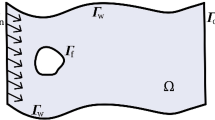Abstract
This paper presents a solution of a shape optimization problem of a flow field for delaying transition from a laminar flow to a turbulent flow. Mapping from an initial domain to a new domain is chosen as the design variable. Main problems are defined by the stationary Navier–Stokes problem and an eigenvalue problem assuming a linear disturbance on the solution of the stationary Navier–Stokes problem. The maximum value of the real part of the eigenvalue is used as an objective cost function. The shape derivative of the cost function is defined as the Fréchet derivative of the cost function with respect to arbitrary variation of the design variable, which denotes the domain variation, and is evaluated using the Lagrange multiplier method. To obtain a numerical solution, we use an iterative algorithm based on the \(H^{1}\) gradient method using the finite element method. To confirm the validity of the solution, a numerical example for two-dimensional Poiseuille flow with a sudden expansion is presented. Results reveal that a critical Reynolds number increases by the iteration of reshaping.








Similar content being viewed by others
References
Azegami, H.: A solution to domain optimization problems (in Japanese). Trans. Jpn. Soc. Mech. Eng., Ser. A 60(574), 1479–1486 (1994)
Azegami, H.: Regularized solution to shape optimization problem (in Japanese). Trans. Jpn. Soc. Ind. Appl. Math. 23(2), 83–138 (2014)
Azegami, H., Fukumoto, S., Aoyama, T.: Shape optimization of continua using NURBS as basis functions. Struct. Multidiscip. Opt. 47(2), 247–258 (2013). doi:10.1007/s00158-012-0822-4
Azegami, H., Kaizu, S., Takeuchi, K.: Regular solution to topology optimization problems of continua. JSIAM Lett. 3, 1–4 (2011)
Azegami, H., Takeuchi, K.: A smoothing method for shape optimization: Traction method using the Robin condition. Int. J. Comput. Methods 3(1), 21–33 (2006)
Azegami, H., Wu, Z.Q.: Domain optimization analysis in linear elastic problems: Approach using traction method. JSME Int. J. Ser. A 39(2), 272–278 (1996)
Belson, A.B., Semeraro, O., Rowley, C.W., Henningson, S.D.: Feedback control of instabilities in the two-dimensional Blasius boundary layer: the role of sensors and actuators. Phys. Fluids 25(054106) (2013). doi:10.1063/1.4804390
Camarri, S., Iollo, A.: Feedback control of the vortex-shedding instability based on sensitivity analysis. Phys. Fluids 22(094102) (2010). doi:10.1063/1.3481148
Chenais, D.: On the existence of a solution in a domain identification problem. J. Math. Anal. Appl. 52, 189–219 (1975)
Davis, T.: Algorithm 832: UMFPACK, an unsymmetric-pattern multifrontal method. ACM Trans. Math. Softw. 30, 196–199 (2004)
Fani, A., Camarri, S., Salvetti, V.M.: Stability analysis and control of the flow in a symmetric channel with a sudden expansion. Phys. Fluids 24(084102) (2012). doi:10.1063/1.4745190
Glowinski, R., Pironneau, O.: On the numerical computation of minimum-drag profile in laminar flow. J. Fluid. Mech. 72(2), 385–389 (1975)
Hadamard, J.: Mémoire des savants etragers. Oeuvres de J. Hadamard, chap. Mémoire sur le probléme d’analyse relatif á l’équilibre des plaques élastiques encastrées, Mémoire des savants etragers, Oeuvres de J. Hadamard, pp. 515–629. CNRS, Paris (1968)
Haslinger, J., Mäkinen, R.A.E.: Introduction to Shape Optimization: Theory, Approximation, and Computation. SIAM, Philadelphia (2003)
Haslinger, J., Málek, J., Stebel, J.: Shape optimization in problems governed by generalised Navier–Stokes equations: existence analysis. Control Cybern. 34(1), 283–303 (2005)
Huan, J., Modi, V.: Optimum design of minimum drag bodies in incompressible laminar flow using a control theory approach. Inv. Probl. Eng. 1(1), 1–25 (1994)
Huan, J., Modi, V.: Design of minimum drag bodies in incompressible laminar flow. Inv. Probl. Eng. 3(1), 233–260 (1996)
Imam, M.H.: Three-dimensional shape optimization. Int. J. Num. Meth. Eng. 18, 661–673 (1982)
Kaizu, S.: The Gateau derivative of cost functions in the optimal shape problems and the existence of the shape derivatives of solutions of the Stokes problems. JSIAM Lett. 1, 17–20 (2009)
Katamine, E., Azegami, H., Tsubata, T., Itoh, S.: Solution to shape optimization problems of viscous flow fields. Int. J. Comput. Fluid Dyn. 19(1), 45–51 (2005)
Katamine, E., Nagatomo, Y., Azegami, H.: Shape optimization of 3d viscous flow fields. Inv. Probl. Sci. Eng. 17(1), 105–114 (2009)
Marquet, O., Sipp, D., Jacquin, L.: Sensitivity analysis and passive control of cylinder flow. J. Fluid. Mech. 615, 221–252 (2008)
Mizushima, J., Shiotani, Y.: Structural instability of the bifurcation diagram for two-dimensional flow in a channel with a sudden expansion. Comput. Methods Appl. Mech. Eng. 420, 131–145 (2000)
Mohammadi, B., Pironneau, O.: Applied shape optimization for fluids. Oxford University Press, Oxford (2001)
Pironneau, O.: On optimum profiles in Stokes flow. J. Fluid. Mech. 59(1), 117–128 (1973)
Pironneau, O.: On optimum design in fluid mechanics. J. Fluid. Mech. 64(1), 97–110 (1974)
Pironneau, O.: Optimal Shape Design for Elliptic Systems. Springer-Verlag, New York (1984)
Sano, M., Sakai, H.: Numerical determination of minimum drag profile in Stokes flow (in case of two-dimensional finite region and constant cross-sectional area). Trans. Jpn. Soc. Aeronaut. Space Sci. 26(71), 1–9 (1983)
Shapira, M., Degani, D., Weihs, D.: Stability and existence of multiple solutions for viscous flow in suddenly enlarged channels. Comput. Fluids 18, 239–258 (1990)
Sipp, D., Marquet, O., Meliga, P., Barbagallo, A.: Dynamics and control of global instabilities in open flows: a linearized approach. Appl. Mech. Rev. 63(030801), 1–26 (2010). doi:10.1115/1.4001478
Sokolowski, J., Zolésio, J.P.: Introduction to Shape Optimization: Shape Sensitivity Analysis. Springer-Verlag, New York (1992)
Author information
Authors and Affiliations
Corresponding author
About this article
Cite this article
Nakazawa, T., Azegami, H. Shape optimization of flow field improving hydrodynamic stability. Japan J. Indust. Appl. Math. 33, 167–181 (2016). https://doi.org/10.1007/s13160-015-0201-9
Received:
Revised:
Published:
Issue Date:
DOI: https://doi.org/10.1007/s13160-015-0201-9




